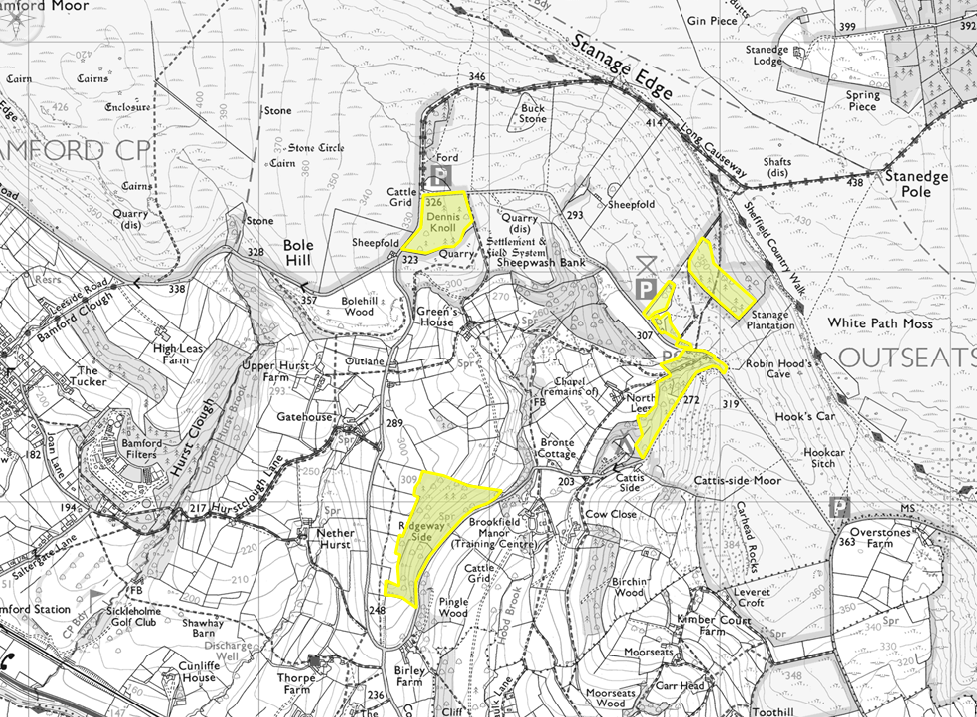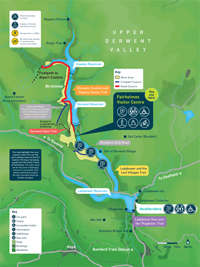FAQs - Tree felling: Larch Disease

Tree felling for larch disease control
A number of areas of woodland in the Peak District National Park have been confirmed to have an infection of Phytophthora ramorum (P.ramorum) or 'larch diease'. Areas affected may be served with a Statutory Plant Health Notice (SPHN) by Forestry England which requires, by law, that the landowner takes appropriate action to fell and remove any trees impact by the outbreak and minimise likely future spread.
As a result, you may find areas of woodland or adjacent rights of way are closed while these works take place. Please follow all signage as instructed both for your own safety whilst heavy equipment may be operating unseen, and also to minimise further spread of the disease.
At each location the landowner is responsible for works under the SPHN, and this may not be the Peak District National Park Authority.
What is Phytophthora ramorum?
Phytophthora ramorum (P.ramorum) is a form of water mould which affects both the foliage and bark of infected trees causing cankers (lesions which exude fluid). This infection can lead to the gradual death of branches and needles/leaves of infected trees, with the tree dying once the lesions become extensive on the main trunk.
P.ramorum affects over 150 different species of plants. Larch trees are highly susceptible to the disease and have been badly infected in some of our woodlands alongside sweet chestnut trees and Rhododendron. Sycamore and beech trees are also susceptible to the disease, but are likely to recover once any infected larch and sweet chestnut trees have been removed.
To find out more about P.ramorum, visit: Forest Research. If you spot any of these symptoms on trees while you are out and about, report them here: TreeAlert
Further FAQs are shown below.
Upper Derwent Valley - Howden / Derwent reservoir loop
Landowner: Severn Trent (partnership management site)
From mid-September 2022, the landowner will be carrying out forest management work in the woodland on the west side of Derwent reservoir (north of Fairhlolmes Visitor Centre) to help contain the spread of Phytophthora ramorum.
The works will require the use of mechanical harvesters and forwarders to fell, process, and remove the trees from the woodland, in some locations it will be necessary to have machinery operating from the road. During this time the landowner will need to close some footpaths and roads.
After felling there will be planting of a mix of native and forestry stock trees, these are more resilient to disease and will allow the landowner to continue to sustainably manage the area for years to come. Great care will be taken during the work to protect the many species who call this area home.
Map of Fairholmes closures - click/touch to expand
Please note:
- Derwent Lane and normal road access from the A57 (Snake Pass) south from the visitor centre itself remains unaffected by any routine closures.
- There will be no access to any users north of the visitor centre along the western edge of Howden reservoir.
- Cycle Hire services remain open for business at Fairholmes, for routes to the south and east of the visitor centre
Stanage Plantation and other woodlands on the Stanage-North Lees estate
In April 2021, the presence of Phytophthora ramorum, a highly infectious plant disease, was confirmed in woodlands on the North Lees Estate, including Stanage Plantation. In January 2022, the presence of P. ramorum was confirmed in more woodlands on the North Lees Estate, including Dennis Knoll Plantation, Tain Wood and Ridgeway Side.
The map below shows the areas of woodland which have been confirmed to be infected with P.ramorum (yellow).

Why are trees being felled?
The Forestry Commission have issued a Statutory Plant Health Notice (SPHN) for areas of our woodland which are infected with P.ramorum (see map above). This legally requires us (the owners of the woodland) to fell all the larch and sweet chestnut trees within these areas.
These trees are being cut down and removed to help prevent the further spread of the disease to other areas of woodland on the estate and in neighbouring woodlands.
Cutting down diseased and highly susceptible species such as larch helps to protect other areas of woodland which could be infected. We will be removing the infected timber from site and will be restoring and enhancing the site through natural regeneration and re-planting in due course.
Felling operations
Felling and extraction operations will be undertaken at Stanage Plantation, Dennis Knoll Plantation, Tain Wood and Ridgeway Side.
Felling will be undertaken by hand and by harvester where possible, with the use of banksmen to ensure that some Public Rights of Way and Access Land will remain open to the public. In Tain Wood and Ridgeway Side, access to and through the woodlands will need to be closed for a short period when operations are in progress, for reasons of public safety.
The roadside tree safety works involve removal/ pollarding of several large beech trees and will open up glades and open spaces within the woodland and hopefully contribute towards re-structuring the woodland, as well as addressing the hazards posed by these over-mature trees (three have suffered major limb failures over the road in the last 5 years).
Parking at Hollin Bank Car Park & Dennis Knoll Car Park
Part of Hollin Bank car Park will be used to stack and store timber prior to removal from site. The other part will remain open to the public, please follow on site signage to ensure you park in the correct area. Part of Dennis Knoll car park may need to be used for stacking and storing timber prior to removal from site. Please continue to use the remaining open areas of car parks and do not park on roadside verges as this can create additional problems for large vehicles removing timber and emergency services. On site signage will direct you to areas available for parking.
What happens next?
Felling and extraction operations will be carried out sensitively to avoid damage to the surrounding SSSI and archaeological features. Extraction routes have been chosen carefully to avoid designated features.
Once all felling and extraction operations have been completed, we will be working closely with our Landscape and Ecology teams to manage the re-stocking of any felled areas through natural regeneration and re-planting with a mixture of broadleaf species, including oak, birch, alder and rowan.
We will be undertaking vegetation enhancement along extraction routes once works are complete. Part of his will involve spreading heather brash sourced from the moorlands above, containing heather seed, along the extraction route. The seed will hopefully establish where bracken beds have been disturbed. In the future, braken control will be targeted in areas where heather re-establishes. We will also be working closely with our Ecology and Countryside Maintenance teams to enhance the surrounding SSSI land once extraction of timber has taken place.
Even though the felling of infected areas will change the feel and look of our woodlands, this is an opportunity for us to look at how we can help to make our woodlands resilient to other tree pests and diseases and other pressures such as climate change.
Why are trees being cut down in some parts of the National Park?
Forestry experts have identified an outbreak of the tree disease Phytophthora Ramorum in areas of the Peak District including the Goyt Valley and Stanage North Lees estate, affecting large numbers of larch (Larix species) trees and a smaller number of Sweet Chestnut (Castanea sativa). As a result of the discovery of the disease, a Statutory Plant Notice now places a legal obligation on the respective landowner(s) to complete work to fell infected trees in the affected area.
Why do the trees need to be cut down/can't they be treated?
Felling is the only effective way to prevent further spread of the disease, and stop it killing other trees and plants in the affected area. Infection occurs through spores dispersed in moisture, including moist air currents so it is essential that affected trees are removed to prevent the spread.
What will happen?
Infected trees will be felled by approved contractors, and removed from the area. Spraying and follow-up felling may continue until 2024.
Will other trees be affected by the works?
Some adjacent tree specimens may need to be removed to allow access to safely fell the affected larch trees, as the removal of larch may leave remaining trees (such as pines) too exposed and susceptible to damage. A small number of infected veteran sweet chestnut trees will be pruned by tree surgeons where applicable to remove the affected branches but retain these valuable trees.
Will the areas affected be re-planted?
The areas affected will be re-planted with tree species that are resilient to the disease to ensure the future of the respective woodlands for generations to come. The felled trees will be used where possible as construction timber, fencing materials, pallet wood and biomass.
The areas affected will be re-planted with tree species that are resilient to the disease to ensure the future of the respective woodlands for generations to come.
Re-planting at Stanage-North Lees is being funded by the Peak District National Park Foundation thanks to generous donations and the fundraising efforts of Peak Running - Run for the Birds. To support more work like this you can donate.
Will any access be restricted?
Rights of way or car park areas used for heavy plant may be temporarily closed when works are underway for public safety, and visitors are urged to observe all diversions or closures.
Route closures will be notified and supported by on-site signage.
What about the future landscape?
Forestry England will be working with the National Park Authority to ensure valuable features including wildlife and archaeology are impacted as little as possible by these necessary works. We will also support the plans to re-plant the woodland and ensure it remains representative and complimentary to the Peak District landscape of the area.
What is Phytophora?
P Ramorum is a non-native, fungus-like organism first discovered in the UK in 2002. It causes disease on trees, shrubs and plants in woodland, heathland, gardens and nurseries. As a form of water mould P. Ramorum affects both the foliage and bark of infected trees causing cankers (lesions which exude fluid). This infection can lead to the gradual death of branches and needles/leaves of infected trees, with the tree dying once the lesions become extensive on the main trunk.
P.ramorum affects over 150 different species of plants. Larch trees are highly susceptible to the disease and have been badly infected in some of our woodlands alongside sweet chestnut trees and Rhododendron. Sycamore and beech trees are also susceptible to the disease, but are likely to recover once any infected larch and sweet chestnut trees have been removed.
To find out more about P.ramorum, visit: Forest Research. If you spot any of these symptoms on trees while you are out and about, report them here: TreeAlert
Can I help stop the spread of Phytophora?
Phytophthora Ramorum ‘Larch disease’ is a plant pathogen and is harmless to people and animals. You can help reduce its impact in the countryside through the following actions:
- Clean soil and mud from boots, shoes and bike tyres before leaving woodland
- Thoroughly wash boots/shoes/tyres (preferably with disinfectant) before visiting other areas
- Keep to marked paths
- Keep dogs on leads
- Do not remove plant material from woodlands
Last updated: August 2022


